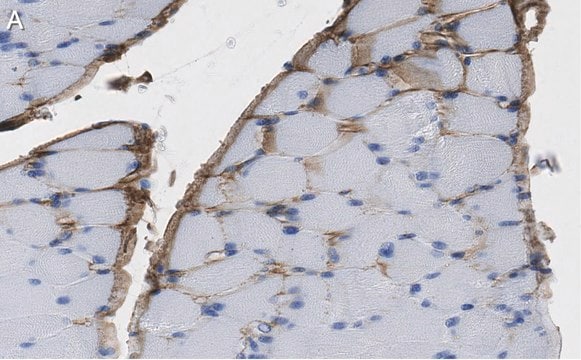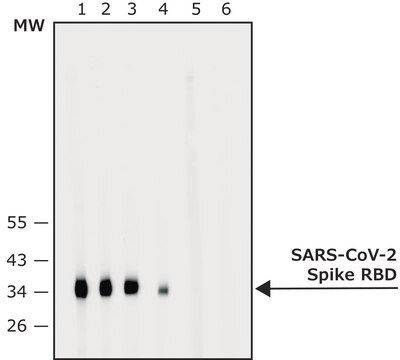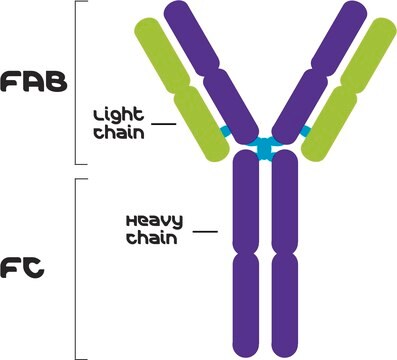ZMS1076
Anti-SARS-CoV-1/2 S Protein Antibody, clone 2B3E5 ZooMAb® Mouse Monoclonal

recombinant, expressed in HEK 293 cells
Synonyme(s) :
Coronavirus S protein, Cov-2 S protein, E2, Peplomer protein, S glycoprotein, SARS-CoV 1/2 Spike glycoprotein
About This Item
Produits recommandés
Source biologique
mouse (recombinant)
Niveau de qualité
Produit recombinant
expressed in HEK 293 cells
Conjugué
unconjugated
Forme d'anticorps
purified antibody
Type de produit anticorps
primary antibodies
Clone
2B3E5, recombinant monoclonal
Gamme de produits
ZooMAb® learn more
Forme
lyophilized
Poids mol.
calculated mol wt 139.13 kDa (SARS-CoV)
calculated mol wt 141.18 kDa (SARS-CoV-2)
observed mol wt ~230 kDa
Espèces réactives
SARS virus
Conditionnement
antibody small pack of 25 μL
Caractéristiques du produit alternatif plus écologique
Waste Prevention
Designing Safer Chemicals
Design for Energy Efficiency
Learn more about the Principles of Green Chemistry.
Validation améliorée
recombinant expression
Learn more about Antibody Enhanced Validation
sustainability
Greener Alternative Product
Technique(s)
ELISA: suitable
affinity binding assay: suitable
flow cytometry: 1 μg/mL
western blot: 1:5,000
Isotype
IgG2aκ
Autre catégorie plus écologique
, Aligned
Conditions d'expédition
ambient
Température de stockage
2-8°C
Modification post-traductionnelle de la cible
unmodified
Informations sur le gène
SARS coronavirus ... S(43740568)
SARS virus ... S(1489668)
Description générale
Each ZooMAb antibody is manufactured using our proprietary recombinant expression system, purified to homogeneity, and precisely dispensed to produce robust and highly reproducible lot-to-lot consistency. Only top-performing clones are released for use by researchers. Each antibody is validated for high specificity and affinity across multiple applications, including its most commonly used application. ZooMAb antibodies are reliably available and ready to ship when you need them.
Learn more about ZooMAb here.
Spécificité
Immunogène
Application
Flow Cytometry Analysis: 1 μg/mL from a representative lot detected SARS-CoV-1/2 S protein in Transfected 293 cells (Courtesy of Dr Thomas Moran, Center for Therapeutic Antibody Development).
Western Blotting Analysis: 1 μg/mL from a representative lot detected SARS-CoV-1/2 S Protein in Vero E6 cells +/- SARS-Cov-2 infection (Courtesy of Jeff Johnson Laboratory, Icahn School of Medicine at Mount Sinai (ISMMS).
ELISA Analysis: A multiple Dilution from a representative lot detected SARS-CoV-1/2 S Protein in S1 fusion protein (Courtesy of Dr Thomas Moran, Center for Therapeutic Antibody Development).
Note: Actual optimal working dilutions must be determined by end user as specimens, and experimental conditions may vary with the end user
Description de la cible
Forme physique
Stockage et stabilité
Informations légales
Clause de non-responsabilité
Data presented is the available current product information and provided as-is. These products have not been tested or verified in any additional applications, sample types, including any clinical use. Experimental conditions must be empirically derived by the user. Our Antibody Guarantee only covers tested applications stated herein and conditions presented in our product information and is not extended to publications.
Vous ne trouvez pas le bon produit ?
Essayez notre Outil de sélection de produits.
Code de la classe de stockage
11 - Combustible Solids
Classe de danger pour l'eau (WGK)
WGK 1
Point d'éclair (°F)
Not applicable
Point d'éclair (°C)
Not applicable
Faites votre choix parmi les versions les plus récentes :
Déjà en possession de ce produit ?
Retrouvez la documentation relative aux produits que vous avez récemment achetés dans la Bibliothèque de documents.
Contenu apparenté
Learn more about ZooMAb® recombinant monoclonal antibody technology and how it can provide greater specificity and improved consistency in your immunoassay applications.
Notre équipe de scientifiques dispose d'une expérience dans tous les secteurs de la recherche, notamment en sciences de la vie, science des matériaux, synthèse chimique, chromatographie, analyse et dans de nombreux autres domaines..
Contacter notre Service technique








